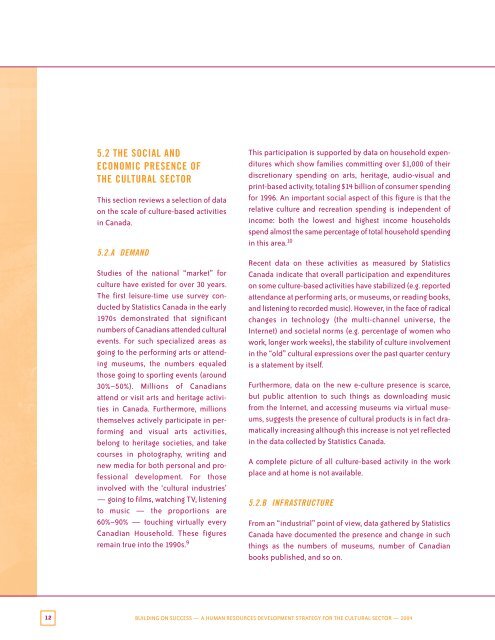Full document
Full document
Full document
Create successful ePaper yourself
Turn your PDF publications into a flip-book with our unique Google optimized e-Paper software.
5.2 THE SOCIAL AND<br />
ECONOMIC PRESENCE OF<br />
THE CULTURAL SECTOR<br />
This section reviews a selection of data<br />
on the scale of culture-based activities<br />
in Canada.<br />
5.2.A DEMAND<br />
Studies of the national “market” for<br />
culture have existed for over 30 years.<br />
The first leisure-time use survey conducted<br />
by Statistics Canada in the early<br />
1970s demonstrated that significant<br />
numbers of Canadians attended cultural<br />
events. For such specialized areas as<br />
going to the performing arts or attending<br />
museums, the numbers equaled<br />
those going to sporting events (around<br />
30%–50%). Millions of Canadians<br />
attend or visit arts and heritage activities<br />
in Canada. Furthermore, millions<br />
themselves actively participate in performing<br />
and visual arts activities,<br />
belong to heritage societies, and take<br />
courses in photography, writing and<br />
new media for both personal and professional<br />
development. For those<br />
involved with the ‘cultural industries’<br />
— going to films, watching TV, listening<br />
to music — the proportions are<br />
60%–90% — touching virtually every<br />
Canadian Household. These figures<br />
remain true into the 1990s. 9<br />
This participation is supported by data on household expenditures<br />
which show families committing over $1,000 of their<br />
discretionary spending on arts, heritage, audio-visual and<br />
print-based activity, totaling $14 billion of consumer spending<br />
for 1996. An important social aspect of this figure is that the<br />
relative culture and recreation spending is independent of<br />
income: both the lowest and highest income households<br />
spend almost the same percentage of total household spending<br />
in this area. 10<br />
Recent data on these activities as measured by Statistics<br />
Canada indicate that overall participation and expenditures<br />
on some culture-based activities have stabilized (e.g. reported<br />
attendance at performing arts, or museums, or reading books,<br />
and listening to recorded music). However, in the face of radical<br />
changes in technology (the multi-channel universe, the<br />
Internet) and societal norms (e.g. percentage of women who<br />
work, longer work weeks), the stability of culture involvement<br />
in the “old” cultural expressions over the past quarter century<br />
is a statement by itself.<br />
Furthermore, data on the new e-culture presence is scarce,<br />
but public attention to such things as downloading music<br />
from the Internet, and accessing museums via virtual museums,<br />
suggests the presence of cultural products is in fact dramatically<br />
increasing although this increase is not yet reflected<br />
in the data collected by Statistics Canada.<br />
A complete picture of all culture-based activity in the work<br />
place and at home is not available.<br />
5.2.B INFRASTRUCTURE<br />
From an “industrial” point of view, data gathered by Statistics<br />
Canada have <strong>document</strong>ed the presence and change in such<br />
things as the numbers of museums, number of Canadian<br />
books published, and so on.<br />
12<br />
BUILDING ON SUCCESS — A HUMAN RESOURCES DEVELOPMENT STRATEGY FOR THE CULTURAL SECTOR — 2004










